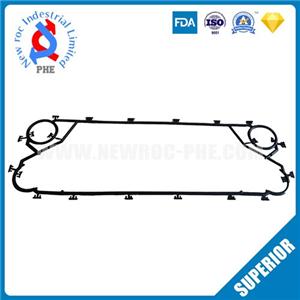How to improve the heat transfer technology of plate heat exchanger
How to improve the heat transfer technology of the plate heat exchanger? In fact, it is only necessary to increase the heat transfer coefficient of the surface on both sides of the plate heat exchanger at the same time, and to reduce the dirt level, and choose the heat exchanger plate with high heat conductivity , Again, it is necessary to reduce the thickness of the heat exchanger plate, so that the heat transfer coefficient of the plate heat exchanger can be effectively improved.
1. Improve the surface heat transfer coefficient of the heat exchanger plates. Because the ripples of the plate heat exchanger can cause the fluid to produce turbulence at a small flow rate (Reynolds number-150), it can obtain a higher surface heat transfer coefficient. The surface heat transfer coefficient is related to the geometry of the heat exchanger plate corrugations and the flow state of the medium. The waveforms of the heat exchanger plates include herringbone, straight, spherical, etc. After years of research and experimentation, it has been found that the corrugated cross-section shape is triangular (the heat transfer coefficient of the sinusoidal surface is large, the pressure drop is small, the stress distribution is uniform under pressure, but the processing is difficult?) High surface heat transfer coefficient, and the larger the angle of the corrugation, the higher the flow velocity of the medium in the flow channel between the heat exchanger plates, and the greater the surface heat transfer coefficient.
2. Reducing the thermal resistance of the fouling layer The key to reducing the thermal resistance of the fouling layer of the plate heat exchanger is to prevent the plate from fouling. When the heat exchanger plate fouling thickness is 1 mm, the heat transfer coefficient is reduced by about 10%. Therefore, attention must be paid to monitoring the water quality on both sides of the plate heat exchanger to prevent the heat exchanger plate from fouling and prevent impurities in the water. The material is attached to the heat exchanger plates. Attention must be paid to water quality and adhesives that cause debris to contaminate the plates of the plate heat exchanger. If there are viscous debris in the water, special filters should be used for treatment. When choosing medicines, it is advisable to choose non-sticky medicines.
3. Choose austenitic stainless steel, titanium alloy, copper alloy, etc. for heat exchanger plates with high thermal conductivity. Stainless steel has good thermal conductivity, with a thermal conductivity of about 14. 4 W/(mK), high strength, good stamping performance, not easy to be oxidized, and the price is lower than that of titanium alloy and copper alloy. It is used a lot in heating engineering, but it is resistant to chlorine The ability of ion corrosion is poor.




